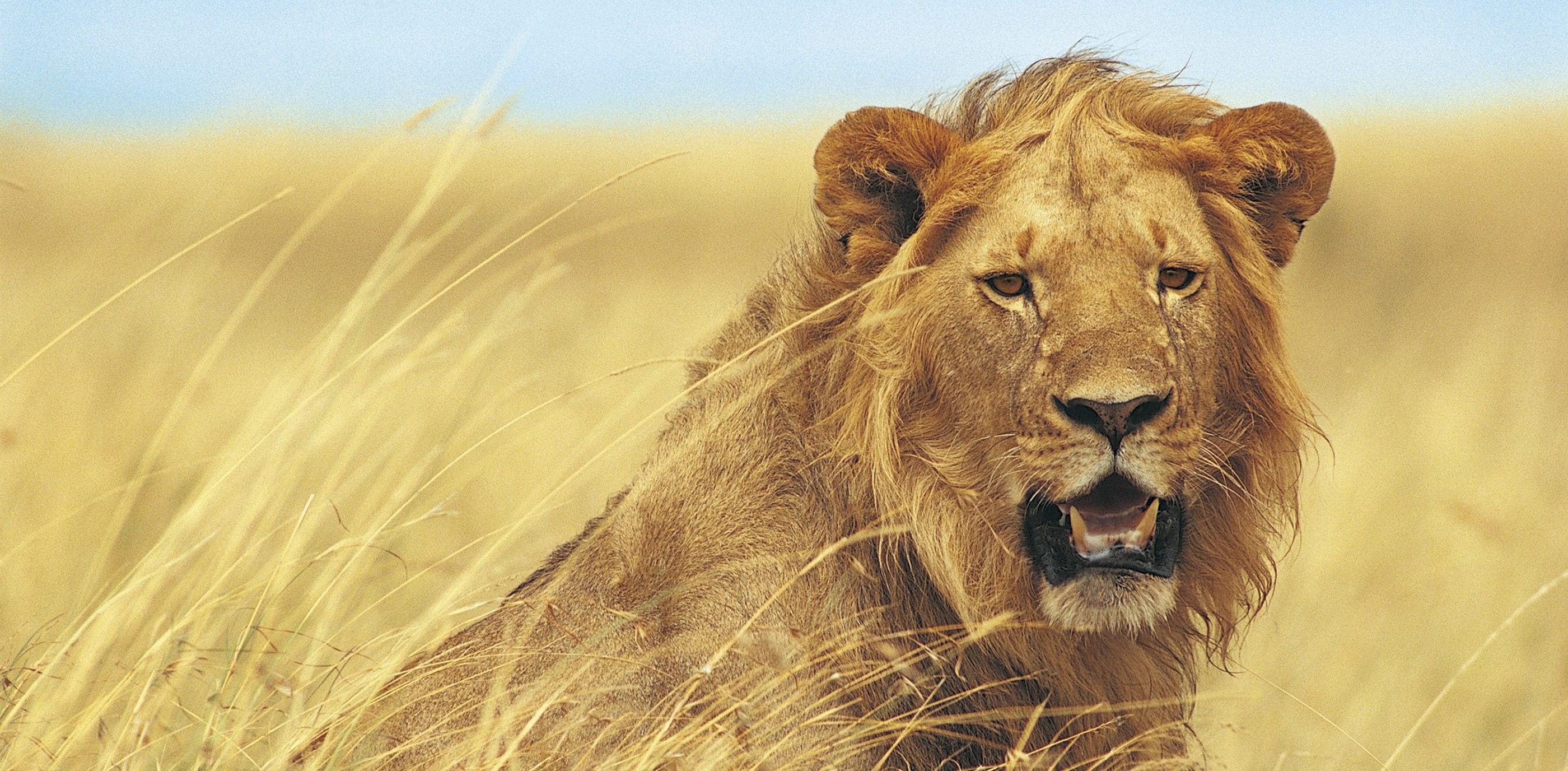From mega-sized to minute and marvelously diverse, African wildlife is awe-inspiring to witness. Untamed herds, solitary predators and innumerable species garnish the rolling hills of the African savanna: a sea of tall grass, thorn bush and acacia groves.
In a single day, explorers on safari can witness lions mate or feast on impalas. Cheetahs lounge on tree branches, baboons gallivant and the zebra and wildebeest braid into each other as they gallop. Wild boar—with mohawks, sideburns and inert, rigid tails—look like balanced trapeze artists as they speedily zip through the brush. Giraffes’ long necks gracefully sway, high above their bodies, as they canter.
If you’re considering a once-in-a-lifetime African safari, this guide will cover:
- Why Go on Safari?
- Top Safari Destinations in Africa
- Southern Africa Region
- Eastern Africa Region
- How to Plan Your Trip
- How to Prepare
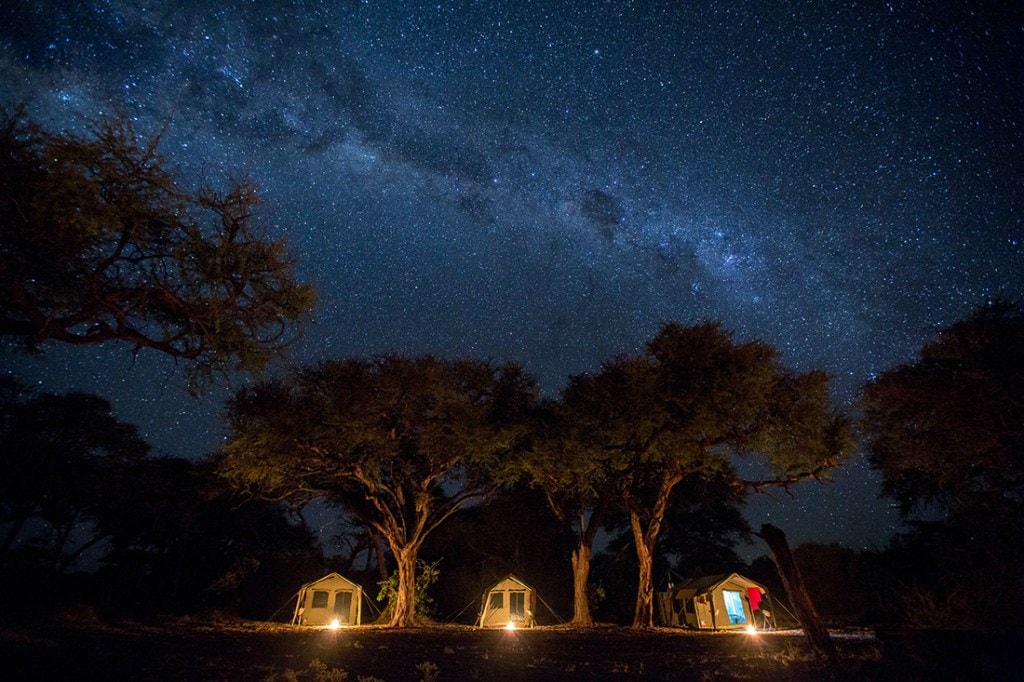
A luminous arm of the Milky Way shines down in Botswana.
Why Go on Safari?
Why take a safari? Because magical moments are behind every corner (and blade of grass) in the African wilderness. Each country and region across this enormous landmass has a unique combination of geography, geology and culture that creates an intoxicating cocktail of adventure. And although zebra, giraffe and lion thrive in most locations, there is a convoy of wild creatures roaming from one mile to the next. So regardless of precise location, you’re bound to have an experience of a lifetime.
“That’s how people get hooked on safaris: they’re each nuanced and you don’t know where the dice will fall with each wildlife encounter—sometimes you get to see the kill, or a termite mound. Seeing these diverse ecosystems thrive makes you feel very small and have a greater appreciation for our planet,” says Jeff Stivers, REI Adventures program manager.
Despite the unpredictability, many safari-goers’ bucket list is comprised of the “Big Five,” the continent’s five most sought-after mammals: lion, leopard, rhino, elephant and African Cape buffalo. The term “Big Five” was initially coined due to the challenge that hunters faced when they pursued these animals, which are considered dangerous for humans to approach.
Top Safari Destinations in Africa
The terrain, ecosystems and wildlife vary greatly across the African continent—which is larger than China, Europe and the United States combined. Regardless of where you venture, each safari trip is an unmatched experience that’s influenced by the geography and culture of the peoples who have long occupied that place.
In general, safaris are categorized by two regions: Southern Africa and Eastern Africa.
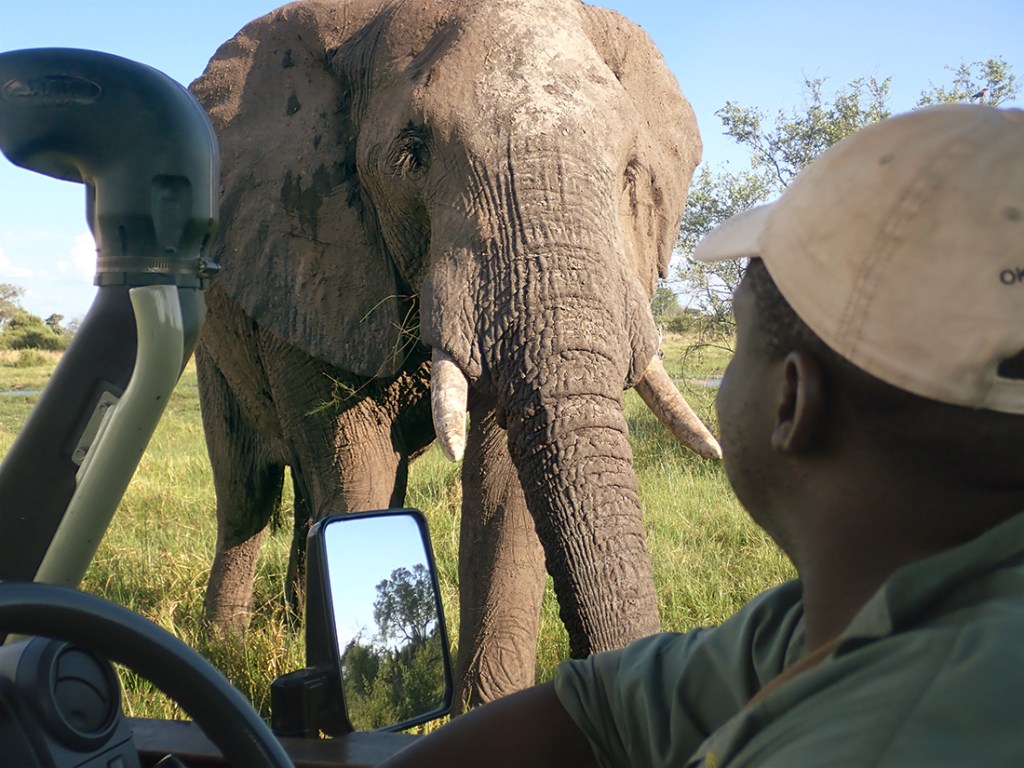
A safari group gets up close and personal with a pachyderm.
Southern Africa Region
Southern Africa is generally much flatter than Eastern Africa. The region spans from Zambia and Malawi to Mozambique, Zimbabwe, Botswana, Namibia and South Africa. This diverse landscape is farther from the equator than Eastern Africa, which causes it to see more dramatic temperature shifts, ergo a more limited time range for a safari experience. In general, the wildlife travels in smaller herds—although that fact doesn’t decrease your chances of spotting animals.
Here are a few spectacular options for Southern African safari adventures:
Zambia
Best for: Walking Safari and Boat Safari
Unique Wildlife Opportunities: Leopard
Best Time to Visit: May to October
Top Locations: South Luangwa, Lower Zambezi, Kafue, Mosi-oa Tunya (Victoria Falls)
Highlights: Zambia is the proclaimed birthplace of the walking safari and nowhere are the guides more adapt and the landscape more ideal. Connect lodge-to-lodge hikes near South Luangwa’s meandering riverways. Catch the massive grasslands of Kafue bustling with game. Boat and jeep safari along the Lower Zambezi, once private reserve of the king, and visit the majestic Victoria Falls.
Namibia
Best for: Walking Safari, Classic Safari, Biking
Unique Wildlife Opportunities: Desert Adapted Rhino and Elephant
Best Time to Visit: May to October
Top Locations: Etosha, Skeleton Coast, Namib-Naukluft, Fish River Canyon
Highlights: Namibia offers seemingly endless desert landscapes with barren sand dunes as far as the eye can see. Travelers can enjoy marine musings and remote exploration along the protected Skeleton Coast, tracking desert rhino and hiking to the ancient petroglyphs of Twyfelfontein in Damaraland, and catching the amalgamation of wildlife in Etosha National Park’s water-filled pans in the dead dryness of winter.
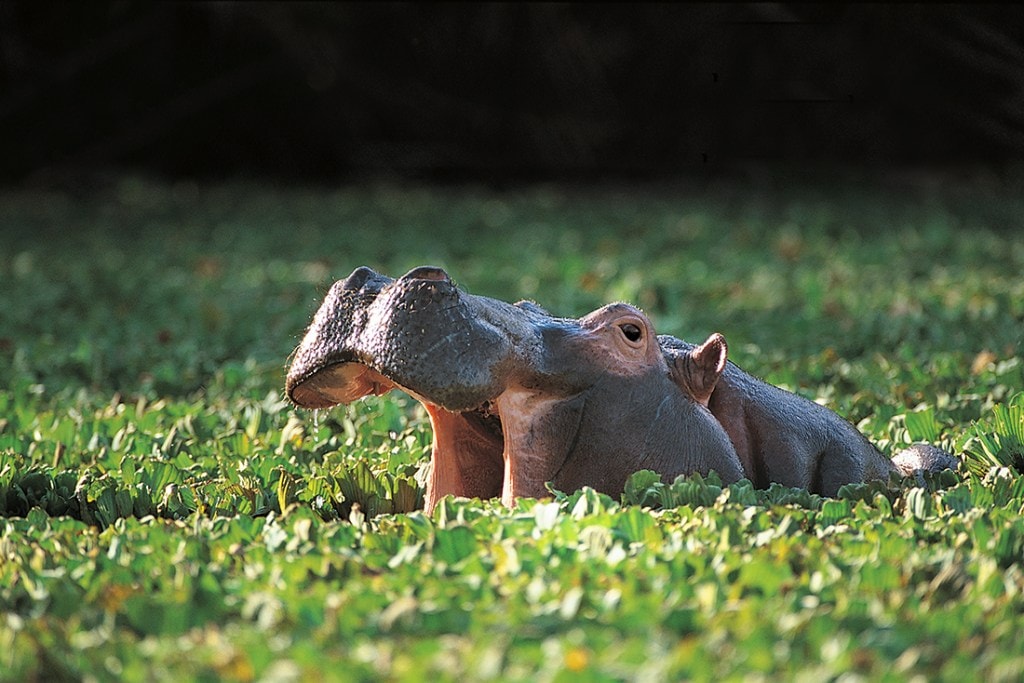
A half-submerged hippopotamus opens its maw wide.
Malawi
Best for: Emerging Safari Locations, Hiking, Kayaking, Lake Islands
Unique Wildlife Opportunities: Classic Safari Wildlife, Black Rhino
Best Time to Visit: May to October
Top Locations: Lake Malawi, Majete, Mt. Mulanje, Liwonde
Highlights: The narrow, elongated country of Malawi hugs a spectacular combo of highlands and lakes, including the massive Lake Malawi—which accounts for more than one-fifth of the country’s landmass. Travelers can explore the country’s four basic regions including the Great Rift Valley, central plateaus, and mountains in addition to the highlands. The Rift Valley is what holds Lake Malawi, and the western and southern shores are full of lagoons and swamps. Animals to spot are hippos, crocodiles, antelope, fish and hundreds of species of birds.
Zimbabwe
Best for: Walking Safari, Classic Safari, Tiger Fishing
Unique Wildlife Opportunities: Leopard, Elephant, General Game
Best Time to Visit: May to October
Top Locations: Victoria Falls, Mana Pools, Hwange Matusadona, Matobo
Highlights: Filled with impressive reserves, Zimbabwe has been and remains a premier destination for safari in Africa. Mana Pools National Park along the Zambezi River is a remote and fun place to canoe past hippos, elephants and Nile crocodiles. Hop on a houseboat and go explore Matusadona, or explore the cave art and wildlife of Matobo.
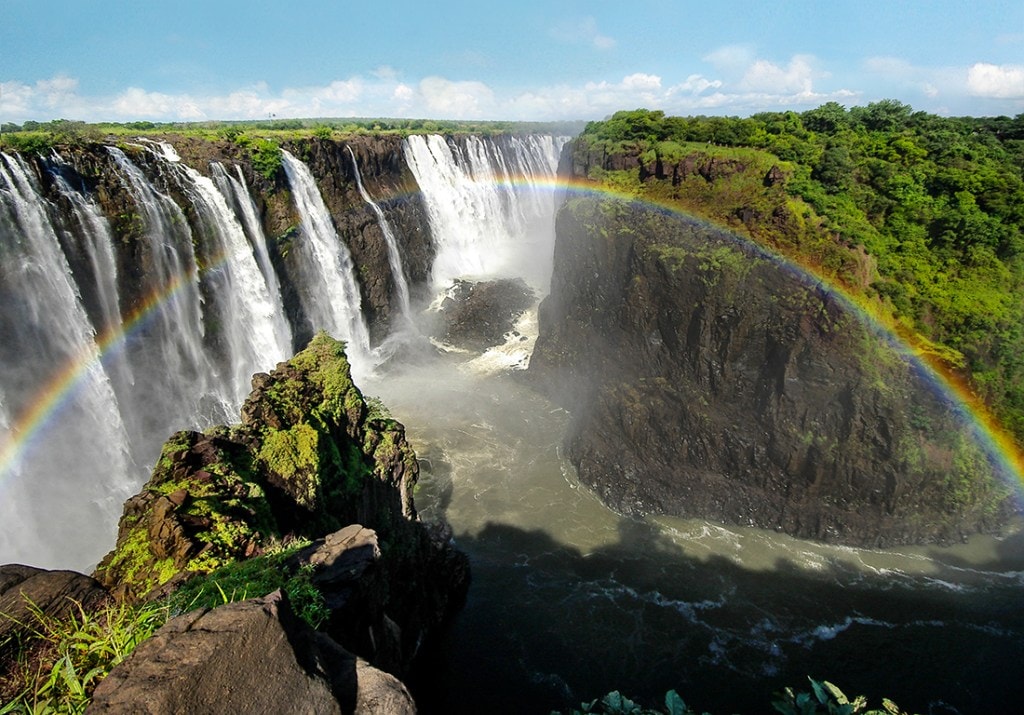
Zimbabwe’s Victoria Falls casts a rainbow.
After or before your safari in Zimbabwe, check out the adventurous activities in the Victoria Falls area. Raft whitewater on the lower Zambezi River, canoe the upper Zambezi, take a helicopter flight or go bungee jumping. Victoria Falls alone is a profound sight. “When you fly in, you can see the spray from Victoria Falls from miles away as it rises up—it’s a giant gash in the earth,” says Stivers. “It’s really fun and impressive to do a hike along Victoria Falls. It’s not super strenuous. In April, May and June the water is higher, so you get blasted by the spray as you walk along the edge. It’s exhilarating to be near the sheer awesome power of the falls.”
Botswana
Best for: Classic Safari
Unique Wildlife Opportunities: Lion, Leopard and Large Herds of Giraffe, Kudu, Vervet Monkey and Baboon
Best Time to Visit: May to October
Top Locations: Moremi, Chobe, Makgadikgadi, Kalahari, Northern Tuli, Okavango Delta
Highlights: One of the largest and least populated expanses of wilderness, the Okavango Delta is a superlative safari destination. The flat pans of the Makgadikgadi and Nxai host an alternate migration to that of the famed Serengeti, and the Kalahari is a unique wilderness that springs to life in spectacular fashion with the coming of the summer rains. Tiptoeing into Chobe for a day tour doesn’t count; go all the way in to really experience Botswana.
“The Okavango Delta is one of the most pristine wildlife locations on the planet. It’s quite remote and the crème de la crème of safari in Southern Africa,” says Stivers. “You can fly from camp to camp or drive around the fingerlike panhandle as the delta ebbs and flows throughout the year.”
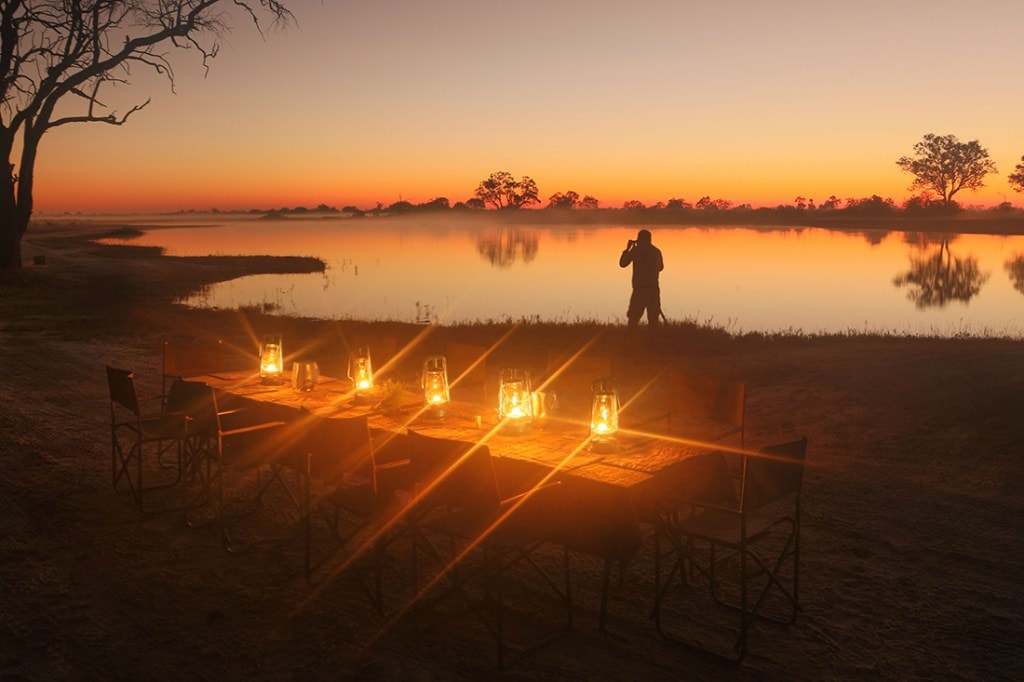
A camp readies to dine under the setting Botwana sun.
The perfect time to visit the Okavango Delta in Southern Africa is from May to November, when it’s the dry winter season and the game-viewing is excellent. “The temperatures are very ‘cold’ at night—down in the 40s—and in the day time, they shoot up to the 70s and 80s, like the Southwest of the U.S. The Kalahari sand doesn’t retain a lot of heat,” says Stivers.
South Africa
Best for: Luxury Safari, Multisport, Family Travel, Cycling
Unique Wildlife Opportunities: Big-Five Game Reserves
Best Time to Visit: Year-Round
Top Locations: Kruger, Hluhluwe-iMfolozi, Maloti-Drakensberg Park, Table Mountain
Highlights: A plethora of small game reserves offer unique, localized getaways. KwaZulu-Natal is a completely different ecosystem and incorporates stunning wetlands, coastal forests and wildlife reserves. The history of apartheid and the struggle for equality is palpable with a visit to Cape Town, which is a unique juxtaposition against the dramatic scenery of Table Mountain, rolling vineyards of the winelands and the hip culinary restaurant scene which makes Cape Town one of the world’s most iconic locations to visit.
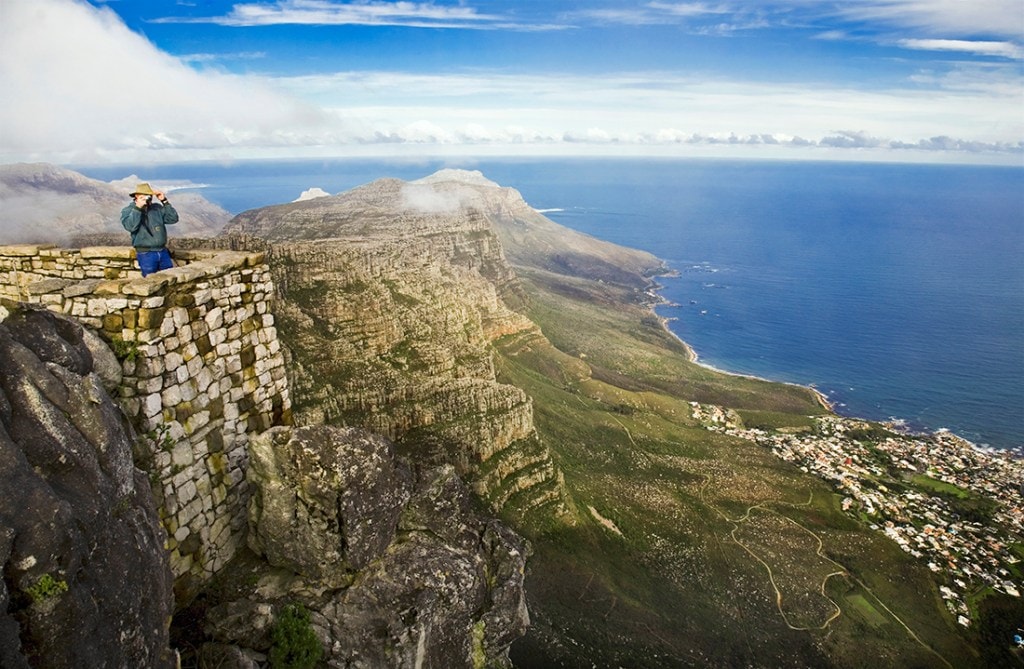
Cape Town’s Table Mountain offers top-notch hiking and superlative views of the tip of Africa.
In South Africa you’ll find a greater number of private game reserves and concessions. These private reserves give travelers a more exclusive opportunity for wildlife encounters—at a higher price point. But beyond these private operations, the safari industry in South Africa is more developed in general, which means that camps and lodges are available for a range of budgets, from catering to luxury to family groups.
South Africa’s safari crown jewel is Kruger National Park, which is the largest and one of the oldest national parks in the entire region of Southern Africa. Visitors can combine their safari with wine tasting and cycling in the Cape Province, as well as hiking in the Drakensberg Mountain Range and a must-do hike for Cape Town visitors to the top of Table Mountain. Post-safari, trail-lovers can also delve into mountain biking and wave-lovers can enjoy the beaches of Cape Town and those of Mozambique, which neighbors South Africa.
Eastern Africa Region
Eastern Africa is covered by the iconic grasslands of the Serengeti-Masai Mara Ecosystems, which bands together the Serengeti region, in northern Tanzania, and Kenya’s Masai Mara. The Mara River winds through the plains of Kenya and Tanzania before entering Lake Victoria, and the river’s flow is the heroic frame of the Great Migration wildlife crossings. The idyllic migration vision that most travelers carry is closer to Eastern Africa’s sights and experiences than Southern Africa. In this region, wildlife generally travel in larger herds or gatherings.
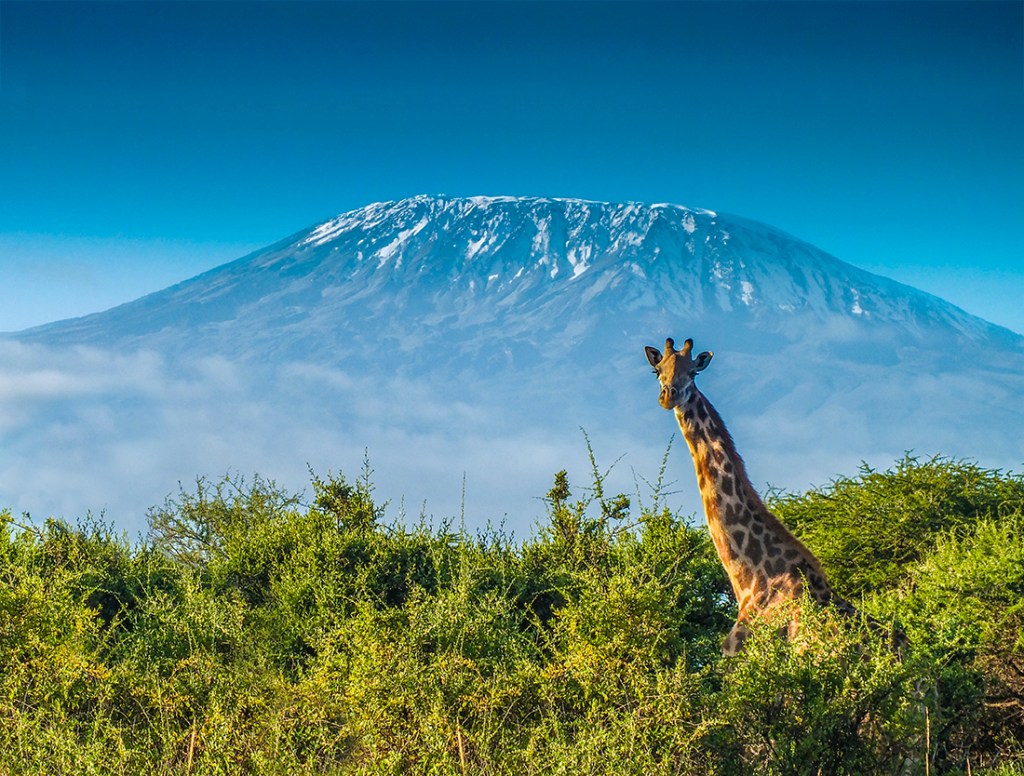
A giraffe roams casually under the dominant flanks of Kilimanjaro.
An array of habitats creates the mosaic of Eastern Africa, from Tanzania and Kenya to Uganda and Rwanda. The Rift Valley’s soda lakes—Nakuru and Manyara—attract large flocks of flamingos. The baobab forests of Tarangire National Park, in Tanzania, shelter big herds of elephant. Ngorongoro Crater is the world’s largest unbroken caldera. Mount Kilimanjaro is Africa’s highest mountain.
Two key factors distinguish Eastern Africa from Southern Africa: the former’s close proximity to the equator, and the rugged, robust terrain of the Rift Valley—which is powerful enough to create a towering mountain like Kilimanjaro, one of the world’s Seven Summits at 19,341 feet. In this region you’ll also find Lake Victoria, one of the African Great Lakes, is held by three countries: Kenya, Uganda and Tanzania.
Also, due to Eastern Africa being closer to the equator, the temperature shifts are not as dramatic and there are greater opportunities for year-round safaris.
You’ll notice safari vehicles that are enclosed rather than open-sided. The reason? In Eastern Africa, a larger number of safari operations combine open-road driving with safari drives, as a way to link up national parks. By contrast, safaris in Southern Africa tend to incorporate more fly-in safari options, thus safari vehicles have no need to be driven on open roads beyond the parks.
Here are a few stellar options for Eastern Africa safari adventures:
Tanzania
Best for: Classic Safari, Cultural Heritage, Great Migration
Unique Wildlife Opportunities: Classic Safari, Cheetah, Lion, Elephant
Best Time to Visit: May to February
Top Locations: Serengeti, Ngorongoro Crater, Tarangire, Kilimanjaro, Ruaha, Selous, Zanzibar
Highlights: Close to the equator, Tanzania is punctuated by the volcanic activity of the Great Rift Valley. Check out the Great Migration in the Serengeti or see the entire Big Five on an epic day in the Ngorongoro Crater, the largest unbroken caldera in the world. Learn about human evolution at Olduvai Gorge, catch the great elephant migration in Tarangire or climb Kilimanjaro.
Craving a cultural experience? Learn about the fascinating number of tribes which make up the tapestry of Tanzania, which the famous Maasai are only one of hundreds. “Everyone blows by the foothills of Kilimanjaro on their way to climb to the summit—but it’s the homeland of the Chagga and other tribal communities; there are dirt roads around the mountain and waterfall stop-offs. There are so many unique cultural elements that a lot of people miss,” says Stivers.
Want to get off-track? Follow Jane Goodall’s footsteps to Gombe Stream for chimpanzees, or try out the massive and less visited southern parks of Ruaha and Selous. And don’t forget to take some time to get underwater on the Swahili coast or an offshore island like Zanzibar or Pemba.
Kenya
Best for: Classic Safari, Cultural Heritage, Great Migration
Unique Wildlife Opportunities: Classic Safari, Private Wilderness Areas
Best Time to Visit: May to February
Top Locations: Masai Mara, Amboseli, Mount Kenya, Ol Pejeta, Shaba, Lake Nakuru
Highlights: Kenya boasts massive and diverse landscapes, from the shores of Lake Victoria to the incredible highlands of Mt. Kenya, to the desert landscapes of Turkana, the country is steeped in history, breathtaking scenery and is the commercial heart of Eastern Africa.
See the Great Migration in the Masai Mara where countless wildlife documentaries have been filmed and lion activity is world renowned. Trek on foot with the Samburu tribe through the highlands, or see rhino up close in a protected conservancy and witness the many herds of elephants sip cool waters seeping up from the glaciers of Kilimanjaro in Amboseli. Additionally, Kenya contains a variety of small private reserves which offer unique and tailored experiences.
Uganda
Best for: Classic Safari, Trekking Safari, Birding
Unique Wildlife Opportunities: Classic Safari, Mountain Gorilla, Chimpanzee
Best Time to Visit: June to August and December to February
Top Locations: Bwindi Impenetrable Forest, Queen Elizabeth, Kibale, Murchison Falls, Kidepo Valley
Highlights: Uganda rests against the northern edge of Lake Victoria and it’s western border is occupied by the Rwenzori Mountains: The range rises from dense forest to high-alpine peaks topped off with snow. Watch the Nile River tumble over Murchison Falls in the morning and scope out a shoe billed stork through your binoculars in the afternoon. Trek to see the region’s mountain gorillas, one of the top wildlife experiences in the world, held in Bwindi Impenetrable National Park.
“Uganda is lush and known as the pearl of Africa,” says Stivers, and adds, “No one ever complains about their experience of seeing family groups of mountain gorillas—which share common ancestry with ourselves—in the wild.”
Rwanda
Best for: Trekking Safari, Cycling
Unique Wildlife Opportunities: Mountain Gorilla, Chimpanzee, Colobus Monkey
Best Time to Visit: June to August and December to February
Top Locations: Volcanoes National Park, Nyungwe Forest, Akagera
Highlights: As a relatively small country geographically, Rwanda punches above its weight. With developed roads, excellent wildlife viewing and a hip, vibrant capital, Kigali, Rwanda is a growing safari destination. Trek through the Nyungwe Forest to find one of the 13 species of primates or 275 species of birds in the country. Explore the towns and cycle the roads surrounding Lake Kivu or try a traditional safari in Akagera.
Volcanoes National Park lies a few hours south of Uganda’s Bwindi Impenetrable National Park. Known for less arduous hikes but higher permit costs, Volcanoes is another top destination for viewing mountain gorillas.
How to Plan Your Trip
Motorized or Human-powered?
Among safari options, explorers can choose drive-only tours (no walking permitted) that are operated by a guide with a pre-developed itinerary. In this case, any traveler can join a group.
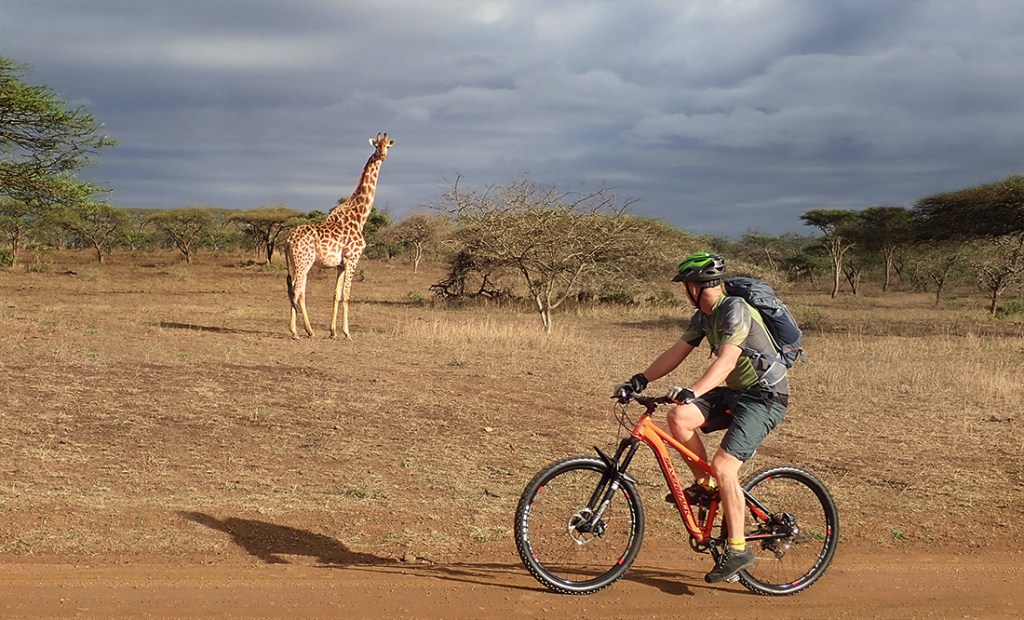
Whether walking, biking or riding in a vehicle, up-close wildlife encounters are to be expected on a trip in Africa.
Beyond drive-only tours, a handful of areas allow safari walks or bike rides. On foot or bike, you won’t be able to cover as much ground in a single day, but the experience of being so close to large game is a thrilling one.
National Park or Private Reserve?
National parks are open to the public, and as in the U.S., they’re owned and managed by the government. Whereas, a private game reserve or concession is privately owned and managed. Both national parks and private reserves in Africa uphold the same regulations regarding land conservation and wildlife protection. But beyond their similarities, there are several key differences between the safari operations within a national park versus privately owned or leased land.
National Parks: Overall, safaris in national parks offer a greater spectrum of options for accommodations. Trip-goers can choose from a menu of flexible, multiday itineraries and various lodge options that fit a range of travel budgets.
However, the scope of activities in a national park is more limited compared to a private reserve, due to a park’s stricter regulations, such as designated opening and closing times. Night drives, off-road exploration, and on-foot safaris are also not permitted in national parks.
The established dirt tracks inside national parks allow people to travel safely in a safari vehicle while being in a close proximity to wildlife. In addition, the vehicles all follow the same paths, which mitigates environmental impact. The tradeoff to driving on set routes is that most vehicles funnel to the same locations when a wildlife sighting occurs (the drivers communicate via radio).
Private Game Reserves: Compared to national parks, private reserves limit the total number of excursionists, resulting in a more exclusive experience, which is reflected in a higher cost. That limited capacity creates a profound sense of solitude for explorers who seek a quieter, more isolated adventure. The capped number of entrants also helps to protect the ecosystem from high traffic.
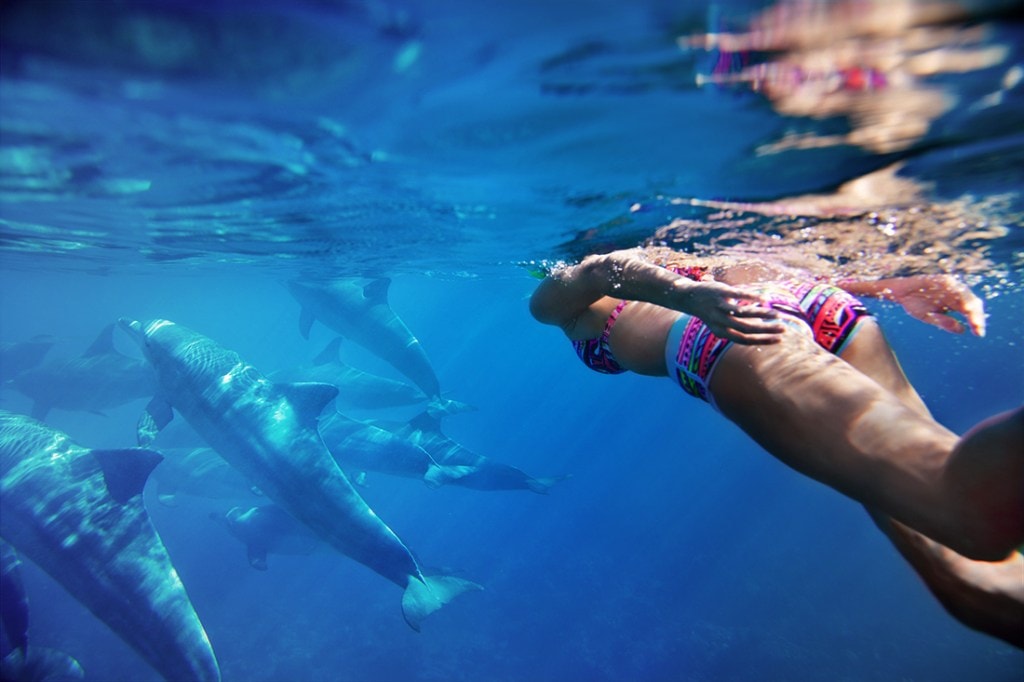
A swimmer encounters dolphins off the coast of Mozambique.
Another key difference? Unlike in a national park, folks can tour off-road and at night in a private game reserve.
Private Concession: A private concession is an area of land that is leased to specific safari operators for private use. These designated parameters include land that’s leased from within a national park’s boundaries. The property also often lies on a park’s periphery. In general, the cost of accommodations in private game reserves and concessions is higher than the overnight options in national parks.
What’s the Best Time for an African Safari?
As you choose your travel dates, consider the cycles of migrations and the weather patterns, but rest assured that the prevalence of wildlife is consistent year-round. No matter when or where you go on an African safari, you’ll enjoy the company of incredible wildlife.
Weather in Southern Africa: The weather patterns in Africa are particular to each country. Each location’s climate is influenced by its proximity to the coastline, mountain ranges and the equator.
In general, Stivers says, the best time for a safari in Southern Africa is May to November, however some locations vary. Farthest south, the weather in the country of South Africa is influenced by both the Atlantic and Indian Oceans, so its weather patterns are mostly unique to the region.
Weather in Eastern Africa: Eastern Africa has a handful of rainy seasons that loop throughout the year and each one arrives with its own personality. “Travel during the green season can offer travelers still-excellent wildlife viewing, far less visitors, and a more appealing setting: fresh green shoots of grass and leaves,” explains Stivers. “It’s a little warmer from Nov to Feb, but one of my favorite times to be on safari.”
The high travel season is June to August, when the region is cool and dry. Be aware that late March to May is the long rainy season. “You can still have good safari; however, if it does rain heavily, the roads get really slippery and the soil is particularly sticky and muddy and tough to drive on,” Stivers continues.
The Great Migration
The annual rain patterns of Tanzania and Kenya influence one of the most massive, stunning movements of wildlife in the world: the Great Migration. During this natural event, 1.3 million wildebeest and hundreds of thousands of zebra and gazelle follow a circuit from Tanzania’s Serengeti National Park to Kenya’s Masai Mara National Reserve. Their clockwise route covers close to 1,800 miles each year.
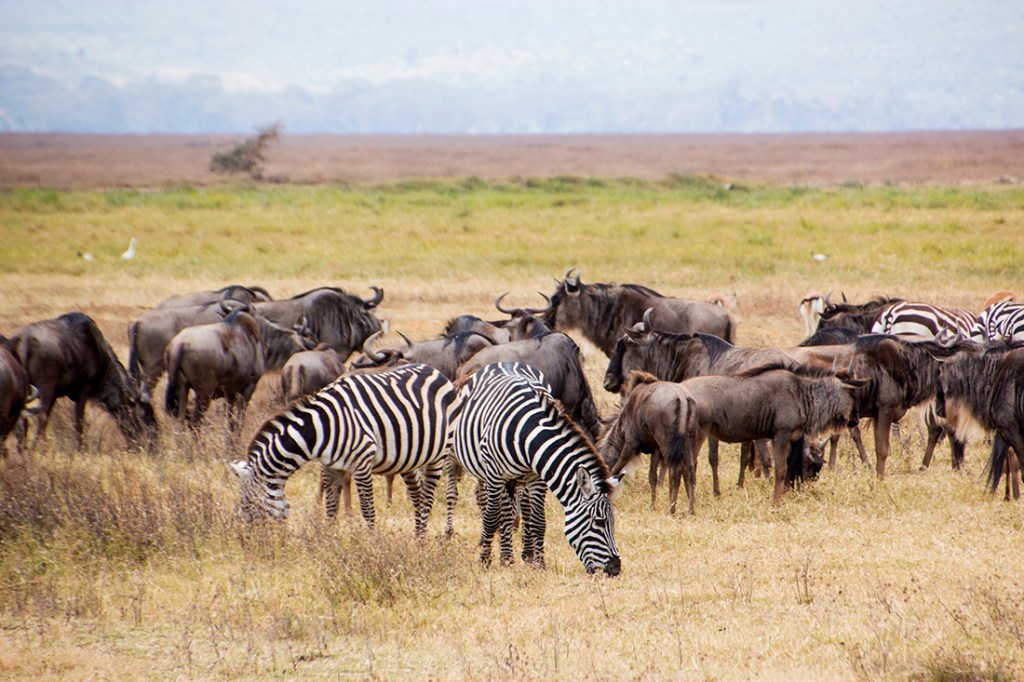
Migrating zebras and wildebeest graze for sustenance.
“It’s interesting that they have a symbiotic relationship: Wildebeest have bad eyes but good hearing, and zebra have good eyes but worse hearing. They’ve teamed up to help protect each other to have the best eyes and ears to keep them safe,” says Stivers.
The basic route: In August, herds depart Tanzania, cross the Mara River and fill the Mara plains until November, when the rains start up in the south. By December, herds return to Tanzania to birth young until March. In April, the rain in Tanzania intensifies, so herds move west and north. In June and July, the movement returns northbound.
How to Prepare
Clothing and footwear
Wearing light, breathable fabrics such as linens and synthetic apparel is ideal for warm, dry climates. Generally, synthetic fabric handles both higher humidity and cooler temperatures well. Be sure to check the overnight lows and consider packing a lightweight or midweight down jacket. For walkable and drive-only safaris, bring a lightweight, long-sleeved shirt or pullover; ones with hoods offer extra sun protection. Also, be sure to bring long pants as they shield your ankles from brush if you’re on a walkable safari.
Neutral-colored clothing is best so that you are camouflaged with the landscape rather than loudly standing out to wildlife. Choose a pair of breathable hiking boots with tall ankles to act as a buffer against abrasive grass, especially on walking tours. No matter what type of safari you do, you’ll be standing quite a bit—even on a game drive—so choose supportive footwear and footbeds.
Accessories
On drive-only safaris, the tops of the jeeps have openings that allow riders to stand up and take photos or enjoy the breeze. As passengers stand, they’re more exposed to the sun and wind. To protect your skin and eyes from dust and sunshine, bring a light neck scarf, brimmed hat and sunglasses. Also, don’t forget to pack binoculars!
Flights
As you search for flights, you might find it helpful to work with a travel agent one-on-one, in order to ensure the most efficient travel route. For example, Swiss International Airlines operates a flight from Nairobi, Kenya, to Zurich, Switzerland (where folks can catch an overseas flight back to the U.S.). However, a handful of those flights (11 hours, 35 minutes) include an unadvertised stop-over to scoop international passengers in another country, which can add 2-3 hours to the flight.
Visa and Passport
Be sure to check the visa requirements for the country where you choose to safari. Some countries allow acquisition of a traveler’s visa upon landing at the airport. In which case, be sure to confirm the currency that the passport control accepts. If they accept U.S. dollars, bring freshly printed bills. A handful of airports, such as Jomo Kenyatta International Airport in Nairobi, only accepts U.S. dollars that were printed after the year 2006.
Camera
The wildlife sightings that you’ll likely experience will be rare and incredible, so bringing a top-notch camera should be a priority. Consider buying or renting a first-rate DSLR camera (one that you enjoy operating), a wide-angle lens for landscapes, and a telephoto lens for zooming in to capture the animals in detail. Pack extra batteries and memory cards. Bring a comfortable camera bag and power adapters, too. Before you depart, attend a photography workshop with a nature or wildlife focus in order to brush up on your skills.
Hydration
Whether you walk or drive, safaris are often unshaded and you experience exposure to the elements: sun, dust, wind and water. Packing electrolyte tablets and a reusable, insulated water bottle can help you stay energized. Also, be sure to pack a water-filtration device of your choice.
Medical
Before your trip, meet with your primary health care provider and research the guidelines (for your planned itinerary) of the Centers for Disease Control and Prevention (CDC) to decide which vaccinations you need. Be sure to book your health care appointments a month or two before your trip departure date. On occasion, vaccinations can be in limited supply or expensive, and some health care offices experience a high volume of patients.
Furthermore, vaccinations can potentially cause folks to feel under the weather within a week of the shot, so it’s best to not risk feeling subpar as a passenger on your safari. Remember to pack your sunscreen and SPF-chapstick to help prevent sunburn. Consider using insect repellent or insect-repellent clothing.
